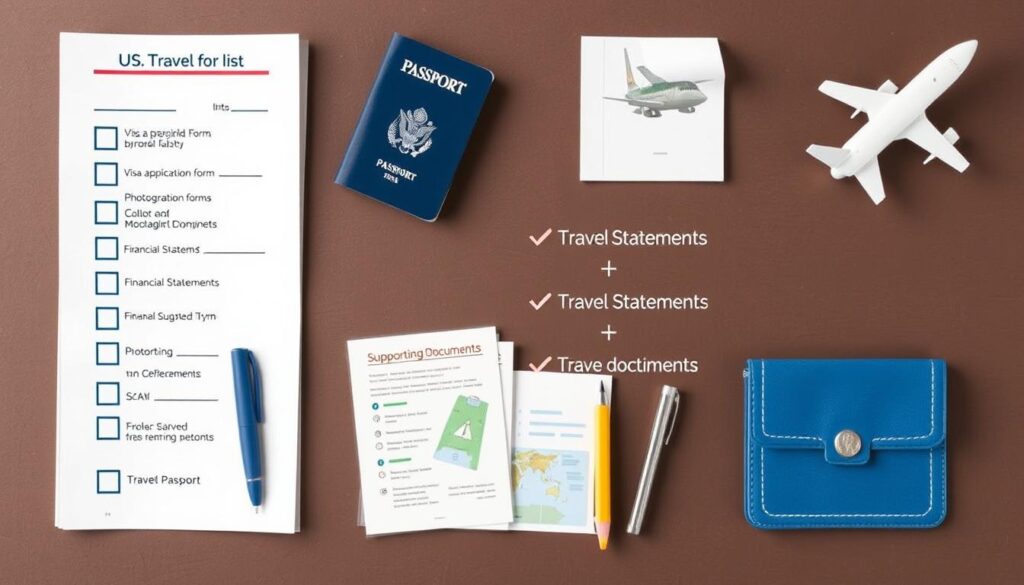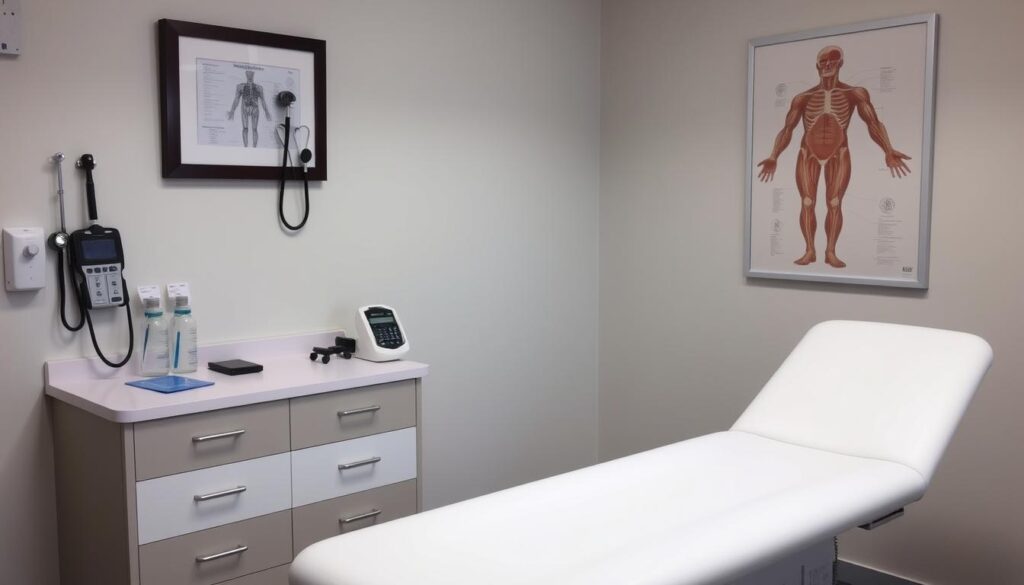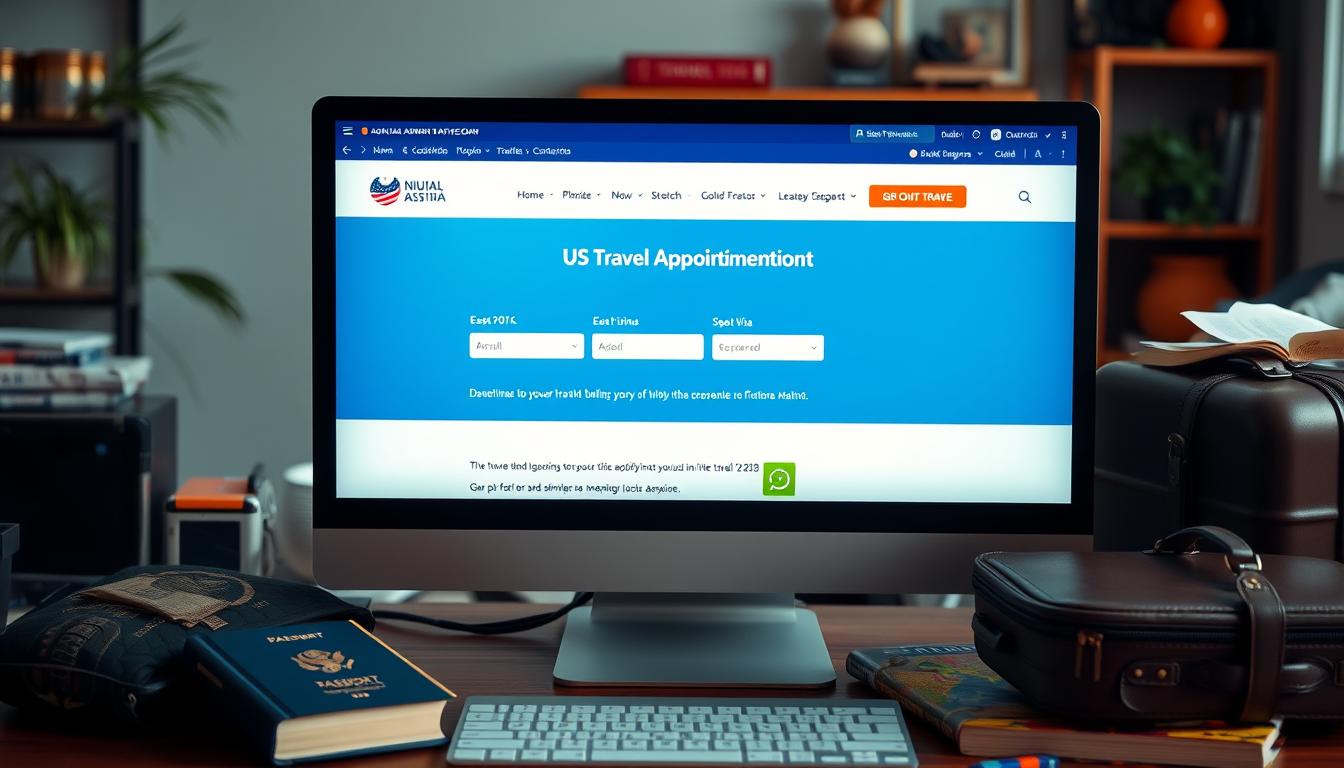Planning a trip to the United States? The first step is securing your visa. This guide will help you through the us visa application process. We’ll cover everything you need to know about scheduling your us travel visa appointment and navigating the visa scheduling system.
The journey starts with understanding the types of visas available and gathering necessary documents. You’ll then move on to completing forms, paying fees, and finally, booking your interview at a U.S. embassy or consulate. With the right preparation, you can make this process smooth and stress-free.
Key Takeaways
- Understand the different types of US visas before applying
- Gather all required documents early in the process
- Complete the DS-160 form accurately
- Pay the $160 visa application fee
- Schedule your appointment through the official visa scheduling system
- Prepare for your interview by reviewing common questions
- Allow ample time for processing, as wait times vary by location
Understanding the US Visa Application Process
Getting a US visa can be tricky. This guide helps you understand the basics. It covers what you need for a visa and the different types of visas.
Types of Non-Immigrant Visas
The US has many visa types for different reasons. You can get a visa for tourism, studying, or work. Each type has its own rules and limits.
| Visa Type | Purpose | Duration |
|---|---|---|
| B1/B2 | Business/Tourism | Up to 6 months |
| F1 | Academic Studies | Duration of study program |
| H1B | Specialty Occupations | Up to 6 years |
Eligibility Requirements
To get a US visa, you need to meet certain criteria. These include your travel purpose, money, and ties to your home country. Most people aged 14-79 must go to an interview. Your passport must be valid for at least six months after your trip.
Application Timeline Overview
The visa application process takes time. Wait times for interviews vary by location and season. It’s best to apply early, especially when many people are traveling.
After your interview, some applications need more processing. This can make the wait even longer.
“Apply early and prepare thoroughly. The key to a smooth US visa application process is understanding the requirements and planning ahead.”
Preparing Essential Documentation
Getting ready for your US visa application means gathering important documents. A good us travel document checklist helps a lot. Knowing what visa documents you need is important to avoid delays.
Required Forms and Documents
Your passport must be valid for at least six months after your US entry date. Bring two identical color photos that meet US standards. You’ll also need the DS-160 confirmation and appointment letter. Family members 14 and older must come to the interview.
- Unexpired passport
- DS-160 confirmation
- Appointment letter
- Two color photographs
- Supporting documents (e.g., income proof, travel itinerary)

Document Translation Requirements
Non-English documents need certified English translations. Bring these on interview day. Your original documents will be returned after the interview. Not having translations can cause delays.
Photo Specifications
Visa photos must follow strict US rules. They should be recent, in color, and against a white background. The head size and position are important. Glasses and headwear are usually not allowed, except in some cases.
| Photo Requirement | Specification |
|---|---|
| Size | 2 x 2 inches (51 x 51 mm) |
| Head Position | Facing camera, full face visible |
| Background | Plain white or off-white |
| Expression | Neutral facial expression |
Remember, having the right documents is key for a successful visa application. Check your us travel document checklist carefully. Make sure you’ve met all visa documentation requirements before your interview.
Completing the DS-160 Form
The DS-160 online application is a key part of your visa process. It asks for personal details and needs your attention to be accurate.
When you fill out the DS-160, you’ll need a 13-character number from USCIS. You must enter your main phone number and list all your surnames as they are in your passport. It also asks about any other nationalities you have or had.
Work history is important too. You’ll need to give info about your last two jobs for the visa interview. Your passport must be valid for at least six months after you plan to arrive in the US.
The DS-160 form is new and replaces old forms. It needs recent photos, no more than six months old, and exactly 2 inches by 2 inches. Make sure to include all family members coming with you to the US in your visa appointment.
Always tell the truth on the DS-160 form. Not doing so can lead to fraud charges and visa denial.
US Consulates watch for alcohol-related issues in applicants. If you’ve had a visa denied before, you must tell them to avoid fraud charges.
| DS-160 Form Requirement | Details |
|---|---|
| Passport Validity | At least 6 months after US arrival |
| Photo Specifications | 2×2 inches, less than 6 months old |
| Employment History | Previous two employers required |
| Other Names | Include maiden name, professional name |
| Nationalities | List all current and previous |
How to Schedule Your US Travel Visa Appointment
Booking your us embassy visa appointment is key in the visa process. The time slots for appointments change based on the embassy and its workload. To make scheduling easy, just follow these steps:
Creating an Account on the Official Portal
First, go to the U.S. Department of State website. Make a personal account with your email and a strong password. This account helps you manage your visa and appointment.
Selecting Embassy Location
Pick the U.S. embassy or consulate closest to you. Remember, wait times for appointments vary by location. For example, the U.S. Embassy in the Philippines has more routine visa appointments since October 2022.
Available Time Slots
Look at the visa appointment calendar for available times. Wait times change each week based on staff and work. Business and tourism (B1/B2) visas often have longer waits.
If you’re traveling with a group of five or more, ask for a group appointment. This might speed up your process. You can change your appointment up to four times without extra fees. For urgent needs, like medical emergencies or school starts, contact the embassy for a fast appointment. Apply early to avoid delays.
“Visa applicants are advised to apply early and well in advance of their anticipated travel dates.”
Understanding Visa Fees and Payment Methods
Figuring out us visa fees and charges can be hard. The price changes with the visa type. Non-petition visas cost $185, while petition-based ones are $205.
E-visas for treaty traders or investors are $315. K-visas for fiancé(e)s or spouses of U.S. citizens are $265.
For L-visa applicants, there’s an extra $500 fraud prevention fee. H-1B and L-1 petitioners face a big $4,500 fee. Immigrant visas have their own prices.
Family-based applications cost $325, while employment-based ones are $345.
Visa payment options are few. In Morocco, cash payments at Banque Populaire are common. Cheques aren’t accepted, and BMCI Bank no longer processes these fees.
After payment, wait until 11 am the next business day to schedule your interview.
Remember, visa fees are non-refundable and non-transferable. Pay the correct amount or risk interview scheduling restrictions.
Keep your receipt safe. You’ll need the CGI reference number to book your appointment. Expired deposit slips won’t work, so stay on top of deadlines.
Understanding these fees and payment rules is key to a smooth visa application process.
Preparing for Your Medical Examination
Knowing what you need for a US visa medical exam is key. The exam by embassy doctors checks if you’re healthy enough to enter the US.
Approved Medical Centers
Only doctors the US Embassy approves can do the exam. These places are ready for the visa process needs.

Required Vaccinations
Applicants must get certain shots. These are:
- COVID-19
- Hepatitis A and B
- Influenza
- MMR (Measles, Mumps, Rubella)
- Polio
- Tetanus
- Varicella
Vaccine costs are $20 to $200. This depends on your age and shots needed.
Validity Period of Medical Results
How long your results are good for changes:
- “No apparent disease or defect” results are good for 6 months.
- “Class B1 (TB)” results are good for 3 months after the last test.
The exam costs $270. It includes blood tests, urine tests, chest x-rays, and a physical. Bring your results to your interview to avoid delays.
| Examination Component | Description |
|---|---|
| Physical Exam | Eyes, ears, nose, throat, heart, lungs, abdomen, lymph nodes, skin |
| Chest X-ray | Required for applicants 15 years and older |
| Blood Tests | Includes test for syphilis |
| Tuberculin Skin Test | For children aged 2 to 14 |
What to Bring to Your Embassy Interview
Getting ready for your embassy interview is key for a US visa. Having the right documents is very important. Let’s talk about what you should bring.
First, make sure you have all your important documents. These are must-haves. If you forget one, it could cause delays or even a denial. Family members 14 and older must come to the interview. But, those under 14 can stay home.
Here’s a list of things you’ll need for your embassy interview preparation:
- Valid passport
- DS-160 confirmation page
- Interview appointment letter
- Recent photograph
- Proof of visa fee payment
- Supporting documents (income proof, travel itinerary, employer letters)
If you’re going for medical care, bring your medical info. For business or tourism, have the right documents ready.
“Preparation is the key to success. Organize your visa interview documents meticulously to ensure a smooth process.”
Remember, sponsors need to fill out the right form. Use capital letters on a computer, sign it, and bring it. No notarization is needed.
| Visa Type | Required Documents | Special Notes |
|---|---|---|
| B-1 (Business) | Business documents, invitation letters | Prove temporary stay intent |
| B-2 (Tourism) | Hotel bookings, tour itineraries | Show ties to home country |
| Medical Treatment | Medical diagnosis, financial statements | Provide treatment plan details |
By following this guide, you’ll be ready for your visa interview. Good preparation helps a lot.
Interview Day Guidelines and Procedures
Getting ready for your US visa interview can be scary. But knowing what to expect can make you feel better. The embassy interview is a big step to get your visa. Being ready is important for success.
Security Screening Process
When you get to the embassy, you’ll go through a security check. This includes metal detectors and checking your bags. To make things easier, don’t bring things like electronic devices or big bags. The security checks are to keep everyone safe.
Interview Etiquette
Your interview will be short, about 2-3 minutes. Dress nicely and get there early. You’ll need to speak English, as it’s the usual language. Officers make decisions fast, so your first impression is key. Answer clearly and simply.
Common Interview Questions
Be ready to talk about why you’re traveling, your ties to your home country, and if you’ll come back. Students, don’t seem like you’re only looking for work in the U.S. Remember, visa applicants are seen as immigrants at first. Show you have strong ties to your home country. Knowing these questions and tips can help you get approved.


